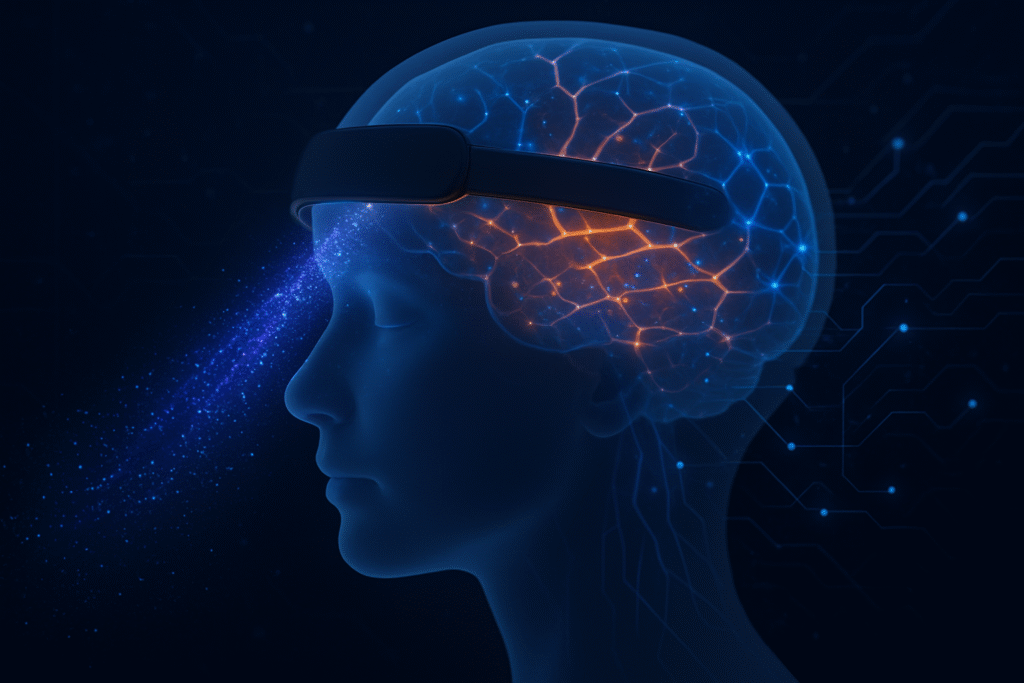
A groundbreaking new noninvasive device, leveraging advanced laser speckle technology, is poised to revolutionize the assessment and management of neurological conditions. This innovative wearable system, developed by researchers from institutions including the California Institute of Technology (Caltech) and the USC Neurorestoration Center, offers a cost-effective and accessible method for continuously monitoring cerebral hemodynamics. Its immediate significance lies in its potential to dramatically improve stroke risk assessment, early detection of traumatic brain injury (TBI), and management of other critical neurological problems, moving beyond the limitations of traditional, often expensive, and inaccessible imaging techniques.
The device's ability to differentiate between superficial scalp blood flow and deeper cerebral blood flow marks a critical advancement, addressing a long-standing challenge in optical brain imaging. By providing real-time, physiological insights into brain health, this technology promises to transform neurological diagnostics, making proactive and continuous monitoring a tangible reality for millions.
Technical Ingenuity: Peering into the Brain with Light
At its core, this device operates on the principles of dynamic light scattering, specifically utilizing Speckle Contrast Optical Spectroscopy (SCOS). A coherent infrared laser (typically around 808 nm) illuminates the brain, and as the light interacts with moving red blood cells, it creates dynamic "speckle patterns" on a high-resolution CMOS camera. The rate at which these patterns fluctuate or "blur" directly correlates with the speed of blood flow. Faster blood flow results in more rapid fluctuations and a lower spatial contrast in the captured image.
Key components include a laser diode, a high-resolution camera, optimized optics for light collection, and a processing unit for real-time analysis. The system generates speckle contrast maps, which are then converted into quantitative cerebral blood flow (CBF) and cerebral blood volume (CBV) data. A critical technical breakthrough involves optimizing the source-to-detector (S-D) distance (ideally 3.0-3.5 cm) and employing advanced multi-detector configurations to reliably distinguish between superficial scalp and deeper cerebral blood flow. This ensures accurate brain-specific measurements, a hurdle that has historically limited light-based neuroimaging.
The device offers noninvasive, wearable capabilities, providing simultaneous measurements of CBF and CBV with high spatial and temporal resolution (tens of microns, milliseconds). It can assess stroke risk by monitoring cerebrovascular reactivity during breath-holding exercises, providing a direct physiological marker of vessel stiffness. Initial reactions from the scientific community are highly positive, with researchers hailing it as a "groundbreaking advancement" with "widespread clinical deployment" potential, particularly due to its non-ionizing nature and potential for continuous monitoring.
This approach significantly differs from previous technologies. Unlike expensive and often inaccessible MRI or CT scans, it's portable, cost-effective, and non-invasive, suitable for point-of-care and community screening. It also offers quantitative, real-time, full-field imaging, contrasting with single-point measurements from traditional laser Doppler flowmetry or the binary (flow/no-flow) assessments of indocyanine green angiography, which requires a contrast agent. While the core is optical physics, Artificial Intelligence (AI) and Machine Learning (ML) are being integrated to refine data analysis, validate effectiveness, predict blood flow, and potentially allow for accurate measurements with less expensive cameras, further enhancing its accessibility.
Industry Ripples: AI, Tech Giants, and Startups Eye New Frontiers
The advent of this noninvasive laser speckle brain blood flow device is set to create significant ripples across the technology and healthcare sectors, presenting both opportunities and competitive shifts for AI companies, tech giants, and nimble startups.
AI companies stand to benefit immensely from the rich, continuous physiological data stream this device generates. Machine learning algorithms will be crucial for processing, interpreting, and extracting actionable insights from complex speckle patterns. This includes noise reduction, signal enhancement, accurate quantification of blood flow parameters, and developing predictive analytics for stroke risk or disease progression. Companies specializing in medical imaging AI, such as Viz.ai and Aidoc (which use AI for real-time stroke detection from traditional scans), can expand their offerings to include laser speckle data analysis, developing sophisticated neural networks for automated diagnosis and personalized treatment recommendations.
Tech giants with established healthcare ventures and robust AI capabilities, such as Alphabet (NASDAQ: GOOGL) (through Google Cloud AI and Verily) and Apple (NASDAQ: AAPL) (via HealthKit and Apple Watch), are well-positioned to integrate this technology into their broader health ecosystems. They can provide the necessary cloud infrastructure for data storage and processing, develop wearable versions, or strategically acquire promising startups in the field. Their resources for extensive R&D could further refine the technology and expand its applications.
Startups are expected to be key innovators, rapidly developing specialized devices and AI/ML solutions. Companies like London-based CoMind, already working on non-invasive brain monitoring with AI analytics, exemplify this trend. These agile firms can target specific clinical needs, offering more accessible and affordable diagnostic tools. Successful startups will likely attract partnerships or acquisition offers from larger medical device companies or tech giants seeking to enter this burgeoning market. The competitive landscape will intensify, pushing companies to invest heavily in specialized AI models for neuroscience and biomedical engineering, while also navigating complex regulatory and ethical AI challenges. The ability to collect, process, and interpret large datasets from these devices will be a significant competitive advantage.
Broader Significance: A Leap Towards Proactive Neurological Care
This noninvasive laser speckle device represents a profound shift in the broader AI landscape, particularly within healthcare, by aligning with the trend towards accessible, continuous, and AI-driven health monitoring. Its wider significance extends beyond mere technological innovation, promising to democratize neurological care and advance our understanding of the brain.
The device's ability to provide cost-effective, real-time cerebral blood flow data addresses critical limitations of traditional imaging, which are often expensive, inaccessible, and episodic. This enhanced accessibility means advanced brain monitoring can reach underserved populations and settings, fostering greater health equity. By enabling early detection and risk assessment for conditions like stroke, TBI, and vascular dementia, it facilitates timely interventions, potentially saving lives and significantly reducing long-term disability. The continuous monitoring capability is vital for critically ill patients, where rapid changes in CBF can have devastating consequences.
While previous AI milestones in medical imaging have largely focused on optimizing the interpretation of existing, often static, images (e.g., AI for radiology improving detection in X-rays, CTs, MRIs), this laser speckle device contributes by generating novel, continuous, and accessible physiological data streams. This new data type provides a fertile ground for AI algorithms to monitor, predict, and intervene in real-time, pushing the boundaries of non-invasive brain health assessment. It complements existing AI-enhanced diagnostics by offering a continuous, proactive layer of monitoring that could detect issues before they become apparent on less frequent or more expensive scans.
Potential concerns include the need for rigorous clinical validation across diverse populations, standardization of data interpretation, and addressing the inherent depth limitations of optical imaging compared to modalities like fMRI. If AI is extensively integrated, issues such as algorithmic bias, data privacy, and the need for explainable AI to build clinician trust will be paramount. Nevertheless, its non-ionizing nature allows for repeated measurements without additional risk, a significant advantage over many existing neuroimaging modalities.
The Horizon: From Wearables to Personalized Brain Health
The future of noninvasive brain blood flow measurement using laser speckle technology is bright, with a clear trajectory towards more portable, accurate, and intelligent systems. Both near-term and long-term developments promise to expand its utility and solidify its role in neurological care.
In the near term (1-5 years), expect to see the proliferation of more compact, wearable devices integrated into headbands, enabling continuous, point-of-care monitoring. Significant advancements will continue in separating brain signals from scalp signals, a crucial step for clinical confidence. The integration of AI and machine learning will become more sophisticated, leading to automated analysis, enhanced pattern recognition, and predictive diagnostics. Techniques like Multi-Exposure Speckle Imaging (MESI) and dual-wavelength LSCI will improve quantitative accuracy, moving beyond relative changes to more precise absolute blood flow measurements. These developments will enable the device to become a standard tool for stroke risk assessment, potentially integrated into routine annual physical examinations.
Looking further ahead (5+ years), the technology could achieve deeper brain imaging, potentially reaching subcortical regions through advancements like microendoscopy. This would unlock insights into a wider range of neurological conditions. Continuous intraoperative monitoring during neurovascular surgeries (e.g., tumor resection, aneurysm repair) is a major long-term application, providing surgeons with real-time, full-field blood flow maps without contrast agents. Experts predict a robust market expansion, with the global market for laser speckle blood flow imaging systems projected to reach $1.4 billion by 2033, driven by demand for non-invasive diagnostics and AI integration. Challenges remain in achieving consistent absolute quantification, further increasing penetration depth non-invasively, and navigating complex regulatory hurdles for widespread adoption.
A New Chapter in Brain Health Monitoring
The development of a new noninvasive device for measuring brain blood flow using laser speckle technology marks a pivotal moment in neurological diagnostics. Its key takeaways include its noninvasive nature, cost-effectiveness, portability, and remarkable ability to differentiate cerebral from superficial blood flow, enabling direct assessment of stroke risk and continuous monitoring of various neurological conditions.
In the annals of AI history, this development is significant not as a standalone AI, but as a powerful AI enabler and beneficiary. It generates the rich, continuous physiological data streams that are perfect for training sophisticated machine learning models, leading to enhanced predictive diagnostics and personalized neurological care. This synergy between advanced optical sensing and AI is poised to redefine how brain health is monitored and managed, moving towards a future of proactive, personalized, and accessible neurological care globally.
In the coming weeks and months, watch for announcements regarding advanced clinical trials and regulatory approvals, which will be critical for widespread adoption. Further integration of AI for automated data interpretation and predictive modeling will be a key area of development. Keep an eye on commercialization efforts and partnerships between research institutions and medical device manufacturers, as these will indicate the speed at which these devices transition from academic prototypes to commercially available solutions. Additionally, observe research exploring new clinical applications beyond stroke risk, such as detailed monitoring in neurosurgery or assessment in neonatal intensive care. The convergence of noninvasive optical technology and advanced AI promises to unlock unprecedented insights into brain health, ushering in a new era of neurological diagnostics and treatment.
This content is intended for informational purposes only and represents analysis of current AI developments.
TokenRing AI delivers enterprise-grade solutions for multi-agent AI workflow orchestration, AI-powered development tools, and seamless remote collaboration platforms.
For more information, visit https://www.tokenring.ai/.





